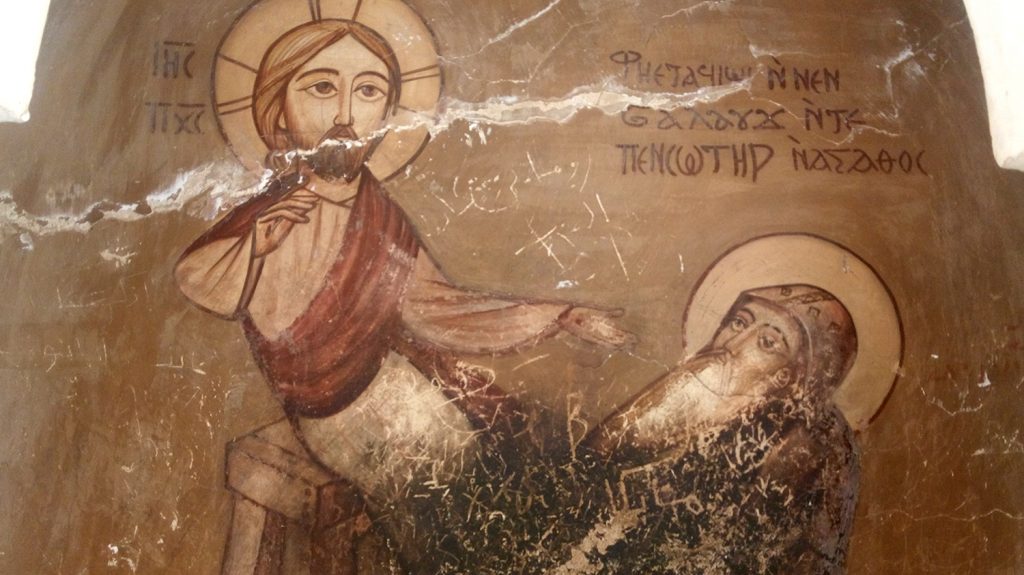Abba Bishoy, the much loved Coptic Desert Father, died today in the year 417. Bishoy‘s strict regime as a monk included him tying his hair with a rope to the ceiling of his cell, to stop him from falling asleep during night prayers. He is renowned for having seen Jesus several times in his life, including an episode in which he helped an old man others had been ignoring, and washed his feet, but then found it was the feet of Jesus he was washing. The icon above pictures this scene from St Bishoy’s life.
It is the feast of St Vladimir, the 10th/11th century Grand Prince of Kievan Rus’. In the year 988, he became the first Russian ruler to turn from paganism and become a Christian. The previous year, he had sent a delegation of 10 men on a fact-finding trip to Bulgaria, Germany and Greece, in search of a religion worthy enough to follow. The delegates came back with negative comments about the German pagans and the Bulgarian Muslims, but they had been wowed by Eastern Orthodox worship in Constantinople, and their report to Vladimir persuaded him to commit to Orthodoxy. He had the biggest idol in the country beaten with sticks and dragged into the River Dnieper; he filled Russia with churches, split up with his 800 mistresses, built schools and became the subject of countless folk songs and legends.
‘Then we went on to Greece, and the Greeks led us to the edifices where they worship their God, and we knew not whether we were in heaven or on earth. For on earth there is no such splendor or such beauty, and we are at a loss how to describe it. We know only that God dwells there among men, and their service is fairer than the ceremonies of other nations. For we cannot forget that beauty.’ Russian Primary Chronicle, report of the emissaries to Vladimir
It is also St Swithun’s Day. According to extraordinarily inaccurate English folklore, if it rains today it will keep raining for the next 40 days. A Bishop of Winchester, Swithun asked to be buried not in the cathedral, but in the churchyard, where his grave ‘might be subject to the feet of passers-by and to the raindrops pouring from on high’. All went well for 108 years, but then the monks of Winchester decided to move St Swithun indoors into a shiny new shrine. On the day of the move, it bucketed with rain, apparently because Swithun was beside himself with fury, which gave rise to the ‘40 days of rain’ folklore.
At midday today in 1099, the siege engines of the First Crusade overwhlemed the Muslim defenders on the walls of Jerusalem. The crusaders sacked the city, which had been under Muslim rule for 450 years, massacring the entire population. Being Friday, they ransacked the mosque and killed all the worshippers, but waited until the next day, the Sabbath, before burning the synagogue, which was full of Jewish worshippers. On the Temple Mount, they waded through corpses and blood a foot deep, and it took them several days to clear the City of God of the corpses. When the massacre became widely known, it horrified many Christians, and its lasting legacy was enmity between Christians and Muslims in the Middle East.
It is the feast of St Bonaventure, the theologian and philosopher who led the Franciscans in the 13th century. It is said that when he was made a cardinal, and his red hat arrived from the Pope, he was busy washing dishes, and so told the Pope’s messengers to hang the hat on a tree because he was up to his elbows in greasy water. Bonaventure wrote a spiritual biography of St Francis of Assisi, who died when Bonaventure was a boy, as well as The Soul’s Journey into God, which is considered his masterpiece.
‘Let us not believe that it is enough to read without unction, to speculate without devotion, to investigate without wonder, to observe without joy, to act without godly zeal, to know without love, to understand without humility, to strive without divine grace, or to reflect as a mirror without divinely inspired wisdom.’ St Bonaventure, Prologue to The Soul’s Journey into God
Image: ديفيد عادل وهبة خليل
